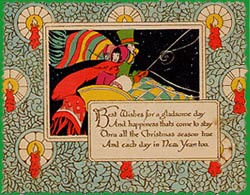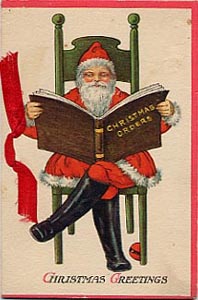History of Christmas Cards
Christmas Cards by the Decade
1920's
Edwardian Christmas Cards
Page Nine
The Victorian Christmas card gave way to a new and popular style. The new cards reflected the Art-Deco/Art Nouveau style of the Edwardian period. The cards are more stylized and fashionable with an emphasis on nature, stylized natural lines, and muted colors. Single-sided cards with a simple design and a short message were used as either visiting cards or signed and mailed in envelopes to a friend, relative or business associate. Lined envelopes appeared in the 20's to accompany the card. Linings came in all shades and colors and designs. It was hoped that this would attract the buyer to the already beautiful cards. Since the recipient of the card usually just ripped the envelope open, lined envelopes from this era are rare. Edwardians continued many of the old Victorian themes, with illustrations of children, New England churches, horse drawn stagecoaches, sleighs or carriages, and nativity scenes. The image of red-breasted robins, deer, or domestic pets was still popular. Cards from the Depression era reflect the resilient nature of Americans and often added a little humor to the subject. American greeting card companies saw substantial growth in the 20's. Hall Brothers, a company of 120 employees in four seperate buildings, outgrew their rental space and in 1923 moved into a brand new six-story plant at 26th and Walnut. It was this same year that the company's name officially became Hall Brothers, Inc. It wasn't until 1925 that "Hallmark" first appeared in limited quantity on some products, but "Hall Brothers" still appeared on most cards. "Hallmark" began appearing in 1927 on the back of every greeting card. 1924 saw the production of the first of their "flats", a laminated, non folding card made of heavy card stock. The ribbons used by Hall Brothers to decorate their cards were now made of silk, satin, rayon and cotton. It was in 1925 that Christmas cards were added to the line. In 1921 the Sapirstein Greeting Card Company (American Greetings) business sales were $11,500, only enough for founder Jacob
Sapirstein to earn about $1,000 that year. But, with the help of his sons
Irving and Morris, sales continued to build over the years. Greetings cards
were purchased by the customer looking through a sample album at a retail
store and requesting the desired card to be pulled from behind the counter.
In 1929 American Greetings were the first to have self-serve display fixtures installed
at retail stores. Now customers could select and pull the card themself.
This 1925 card has a great illustration of Santa reviewing his "Christmas Orders". It opens up and the sentiment is printed on a insert bound in by the red ribbon. The greeting reads "Tis Christmas Day and in my heart, Sweet thoughts of you do rest, And wishes that with happiness Thine every hour be blest." Made in the United States J.P. N.Y.
View Gallery 1 examples (1920 - 1924) BY CLICKING HERE
View Gallery 2 examples (1925 - 1929) BY CLICKING HERE
| |||||||
 By the 1920's the quality of the postcards deteriorated. They were massed produced, giving way to less
elaborate designs. The fine artwork of earlier days became the exception and examples are harder to find.
By the 1920's the quality of the postcards deteriorated. They were massed produced, giving way to less
elaborate designs. The fine artwork of earlier days became the exception and examples are harder to find.
 Carlton Cards was founded in 1920 by Harry Harshman. Its office was located in the downtown section of
Toronto, Canada on Spadina Avenue near Dundas Street. The new company soon out-grew this office space and
had to move to a new facility at Richmond and Peters Streets, also in downtown Toronto. This new office
spanned four levels of the building with press rooms, order processing, distribution, and administration.
Carlton Cards was founded in 1920 by Harry Harshman. Its office was located in the downtown section of
Toronto, Canada on Spadina Avenue near Dundas Street. The new company soon out-grew this office space and
had to move to a new facility at Richmond and Peters Streets, also in downtown Toronto. This new office
spanned four levels of the building with press rooms, order processing, distribution, and administration.